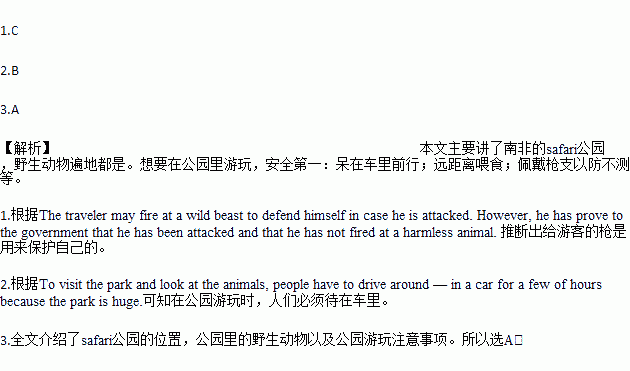题目内容
A safari park is a park in which wild animals are kept. They are mainly located in east or central Africa. They often occupy a very wild area, with mountains and rivers. To visit the park and look at the animals, people have to drive around — in a car for a few of hours because the park is huge.
In south Africa there is a safari park, which contains all sorts of wild animals like lions, elephants, rhinoceroses, zebras, wild pigs, deer and giraffes.
There is a wild road leading through the park, but nobody is permitted to walk on the road. Anyone traveling in the park has to go in a car because wild animals may fiercely attack people. From the car he may see almost every type of African wildlife. Some of these are getting scarce (稀有的) because people kill them for various reasons. For example rhinoceroses are killed for their horns, which are used in traditional Chinese medicines for colds and headaches. Perhaps they will be seen only in museums and books one day.
Travelers may purchase food for the animals. They can feed them when they tour the park. Of course, they should not feed them in a close distance because the wild animals may attack people. In addition, they should only give proper food to the animals.
A traveler may carry a gun with him in his journey. The gun is given to him by the government. However, it is not used for hunting. In fact, a seal is fixed to it. The traveler may fire at a wild beast to defend himself in case he is attacked. However, he has to prove the government that he has been attacked and that he has not fired at a harmless animal.
1.What can we infer from the last paragraph?
A. The gun is given to a traveler by the government.
B. The gun can be used to hunt.
C. The gun is given to a traveler to defend himself.
D. A traveler may fire at a wild beast.
2.Which is the thing people have to do while traveling in the park?
A. Carry a gun with him.
B. Drive around in a car.
C. Look at the animals.
D. Purchase food for the animals.
3.What is the passage mainly about?
A. Some information about traveling in a safari park in South Africa.
B. A brief introduction to wild animals in a safari park.
C. A brief introduction to a safari park.
D. Some information about traveling in South Africa.
 同步练习强化拓展系列答案
同步练习强化拓展系列答案
